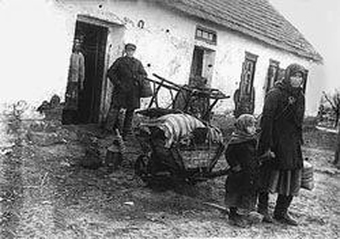Once the Bolsheviks were firmly in control and Stalin had established himself as the man in charge there came a great many changes to Russia during the 1920’s and 1930’s. One major problem Stalin had was the peasants. The majority of the peasants were not communist and often very distrustful of them and other outsiders. Another problem was the grain crisis of 1927. After overseeing the aggressive procurement of grain from the peasants earlier Stalin decided to collectivize them onto state farms.

The Peasants did not approve of this plan. As Freeze states; “But collectivization and the resistance it provoked cost vastly more lives than the October Revolution or even the ensuing civil war.” (Freeze 348) The peasants did not want their right to own private land abolished and to be forced to move and leave all of their possessions.
 This image shows Kulaks being deported.
This image shows Kulaks being deported.
One way Stalin tried to make this process happen was by turning other peasants against the Kulaks. These were the “wealthy” peasants and were staunch resistors of collectivization. Once Stalin had decided to annihilate the Kulaks as a class they could face one of three fates. They could be deported to other districts, be arrested and send to camps or prisons in remote areas, or be pushed to lands that were inferior outside the Kolkhov. (Freeze 349)
 “Let us destroy the Kulaks as a class”
“Let us destroy the Kulaks as a class”
One collectivization had been accomplished the conditions were horrible. In a letter to Ordzhonikidze who was a close friend of Stalin, Feigin states; ” I was in various kolkhozes–not productive and relatively unproductive ones, but everywhere there was only one sight– that of a huge shortage of seed, famine, and extreme emancipation of livestock”. (Feigin letter) Many of the peasants perished form these conditions.
https://www.loc.gov/exhibits/archives/coll.html This line will take you to the Library of Congress with other translated documents about the conditions of the Kolkhozes (collective farms).
While this collectivization was able to help the Bolsheviks maintain power, and to ease some of the burdens of famine, we must not forget what the peasants went through. They were torn from their homes, forced to leave all their belongings, and transported to new areas. Most did not want to go, and were forces. Many resisted and died. So in the end, was it worth it? That question may forever remain unanswered.
Sources:
http://soviethistory.msu.edu/1929-2/collectivization/
https://www.loc.gov/exhibits/archives/coll.html
http://www.voyagesphotosmanu.com/agriculture_soviet_union.html
https://kulaks.weebly.com/what-happened-to-them.html
Russia A History: Gregory L. Freeze.
Nice post Bryan! I like the images you included, they really bring this issue to life. I agree that it is important to remember the brutality that was unleashed on the peasants, and to remember that many of them fought very hard to preserve their way of life.
LikeLike
Those articles on the Library of Congress website are wonderful. What a find! The question you pose at the end is super important. Was it worth it? I suppose the answer depends on your perspective. The human cost was so enormous and so unnecessary (i.e. collectivization could surely have been accomplished in less destructive ways)…how could that ever be worth it? On the other hand, modernizing the economy is essential to victory in the coming war. So some would say that, yes, it was worth it if it meant having the possibility of beating the Germans in WWII.
LikeLike
That Library of Congress link is a fantastic source! This is a solid outline of the issues with collectivization and the peasants’ resistance to it. Was the resistance worth it in the end? I want to say yes, but the resistance did little to change collectivization. Great work!
LikeLike
Great post Bryan! I just have one question that perhaps was answered in your research. If both the peasants and the Kulaks were, for the most part, resistant to collectivization, how was Stalin able to implement his plan? Did he utilize propaganda to successfully turn the peasants against the Kulaks and thereby push for collectivization or was the plan mostly accomplished through brute force in the end?
LikeLike
I really enjoyed this post! It was really nice to see a more in-depth look on this event that we talked about in class. The photos you included really are telling of the nature of the events that took place.
LikeLike